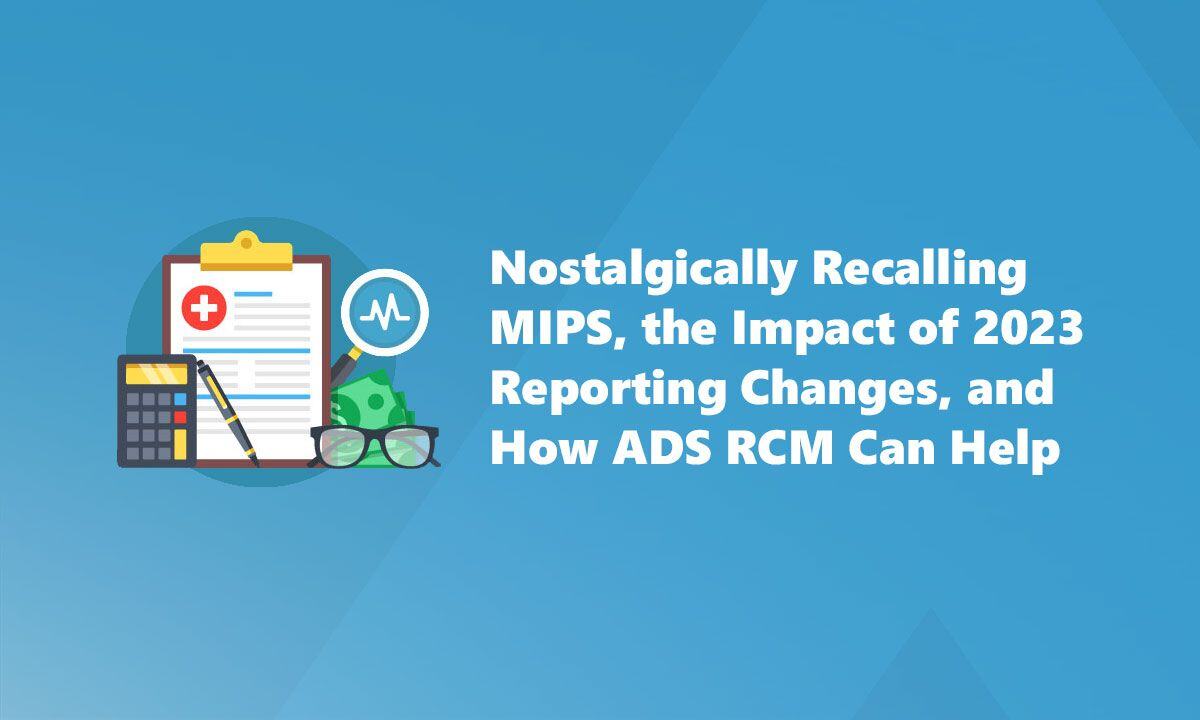Nostalgically Recalling MIPS, the Impact of 2023 Reporting Changes, and How ADS RCM Can Help
The Feel Good Nostalgia: MIPS is the Merit-based Incentive Payment System, a CMS initiative that determines Medicare payment adjustments to eligible providers based on the provider’s overall MIPS performance score. The provider’s MIPS score determines the provider’s reimbursement bonus, reimbursement penalty, or if the provider remains neutral (no bonus or penalty).
Of course, providers would want to obtain a bonus, or at least remain neutral.
As with almost any other CMS initiative or program, MIPS had deadlines, extensions, and exclusions. Perhaps you weren’t deeply tuned into its details, possibly because you thought MIPS wouldn’t significantly impact you/your practice.
By today’s standards, what could’ve been considered “garden variety MIPS” reporting will conclude much more complicatedly in 2023. Essentially, there will be increases in the minimum threshold to avoid penalties. Said differently, the limbo stick (Google if you don’t remember that) is now a few inches from the floor.
So, in support of your effort to excel with MIPS, we present the following need-to-know information to help you prepare for - and avoid - penalties while you do what you do best: provide the best healthcare services for your patients.
Who’s Eligible?
Now that you’ve generally remembered and are refreshed about MIPS, are you eligible? Does it apply to you?
Use the physician lookup tool, which will prompt you to check your status after entering your National Provider Identifier (NPI) number to determine eligibility. If you’re eligible, you’ll have to report enough to remain neutral or perhaps even obtain a bonus vs. being penalized.
You may also have a special status, especially if you work in multiple locations, including hospitals and clinics, and under more than one Tax Identification Number (TIN). Note that MIPS calculations are based on a combination of TIN and NPI, so your scores are relevant at the locations for which you are MIPS-eligible.
Additionally, eligibility is determined based on a 12-month period in which providers must exceed something called the low-volume threshold (LVT), which includes three aspects of the covered services you offer, including all of the following:
- Allowed charges
- Number of Medicare patients who received services through you
- Number of services provided
If you billed more than $90,000 for Part B-covered professional services, and you see more than 200 Part B patients, and you provided more than 200 covered professional services to those patients, you must participate in the MIPS program unless you have an exemption.
In addition to those requirements, you are eligible if you are one of the following types of providers:
- MDs, DOs, DPMs, ODs, DDSs, DMDs, DCs
- Physician assistants
- Nurse practitioners and clinical nurse specialists
- Certified registered nurse anesthetists
- Physical and occupational therapists
- Clinical psychologists
- Qualified audiologists and speech-language pathologists
- Registered dietitians or nutrition professionals
- Clinical social workers
- Certified nurse midwives
The Consequences: Eligible clinicians must report in order to prevent a negative 9% downward adjustment (aka, penalty) for all Medicare Part B claims paid two years from the reporting year. For example, claims submitted in 2023 for which MIPS reporting was lacking will result in penalties on 2025’s reimbursements.
But as noted, penalties are avoidable through quality reporting. And there are multiple reporting options depending on your practice’s specifics. For example, changes in reporting are more specialty-driven, and new reporting may allow providers to only submit what they do at their practice.
The Solution: As you can see, MIPS reporting is becoming complicated, tricky, and unwieldy to the point where individual providers/practices can’t handle proper reporting to avoid that 9% penalty on Medicare reimbursements.
Partnering with a knowledgeable, trusted billing and RCM service with a MIPS staff in place to assist and work with its clients to ensure proper reporting is on track, is an essential resource. That’s especially true because it gets even more complicated, as described in the following pathways.
The Pathways to Reporting
- Traditional MIPS Reporting calls for providers to select the quality measures and improvement activities on which to report and which to communicate to MIPS. In addition, providers will complete the “Promoting Interoperability” measure set. CMS collects and calculates data for the cost performance category on the provider’s behalf.
- The Alternative Performance Pathway (APP) is for eligible clinicians participating in MIPS APMs. They’ll have preset measurements for quality and improvement activities. Quality is ascertained by providing high-level care determined by performance measures created by CMS and by collaboration with medical professionals and stakeholder groups.
- This accounts for half (50%) of the final score. Another 30% of the result is to promote interoperability, such as patient engagement and electronic exchange of information using certified electronic health record technology (CEHRT). The final 20% is from improvement activities, such as improving patient engagement and access to care and your processes supporting them.
- MIPS Value Pathways (MVPs) were created to move away from structured reporting and focus on specific measures and activities that are more important to your practice or specialty and, subsequently, to patients’ health. These allow for specific measures and activities more relevant to a specialty, episode of care, or specific medical condition.
MIPS Reporting Types
There will likely be multiple reporting types to be considered, each having pros and cons:
- Claims-based reporting is for smaller practices. It’s an easier reporting type; fewer measure options exist. And once reported, claims-based is finalized and can’t be changed. It also only covers the quality category.
- EHR vendor whose EHR platform and staff is a more seamless process with more measures than claims-based reporting. A possible drawback is that it's limited to the traditional MIPS program with few measures for specialties. If the EHR vendor has a partnership with a Qualified Clinical Data Registry (QCDR), more measure options are available. (ADS RCM helps clients submit their reporting to our QCDR, but clients can also submit reports to any other QCDR.)
- Qualified Registry if you collaborate with a qualified registry for reporting whereby a third party gathers data from your EHR or practice management system (e.g., the software vendor) and is reported to CMS on your behalf. Many specialists may have their “promoting interoperability” points moved automatically to the “Quality” category based on the specialty. The NPI lookup tool above will outline this in the “special status” section once an NPI is searched.
- Facility-based reporting allows eligible clinicians in the practice to report as part of the facility. For example, providers working at hospitals participating in state-based Medicaid and reporting value-based data to Medicaid might be considered part of the facility’s reporting, not individual reporting. Facility-based Reporting is listed as a special status, viewable when a provider uses the NPI lookup tool mentioned previously.
Wrap-Up on Changes to MIPS
If you think 2023 changes to MIPS are daunting and overwhelming, they are; it’s a rabbit hole of almost incomprehensible reporting regulations:
- You’ll need someone to check the NPI lookup tool for your providers.
- Someone must routinely monitor the Quality Payment Program (QPP) website for new changes.
- Whoever does that must be on QPP’s email list (qpp.cms.gov) for notices of updates and changes.
- And, of course, the reporting itself must be monitored to ensure quality is ideal.
None of this is anything you or your team needs right now, yet you want to ensure you’re not penalized. Two alternatives will help:
- MedicsRCM outsourced services from ADS RCM will guarantee to increase your revenue in 90 days, and our team of MIPS experts is available to help submit your reporting to our QCDR in an attempt to avoid the 9% penalty and ideally, to obtain any bonus to the extent possible based on your stats, or
- The MedicsCloud Suite from ADS if in-house automation is preferred. The Suite comprises the 21st Century Cures Act-certified MedicsCloud EHR for clinical charting and reporting, and the powerful MedicsPremier operational, financial, and workflow management platform.
We’ll work to propel your revenue and productivity, and provide the technology and guidance for successful MIPS reporting. And, our systems will help you comply with initiatives such as the 21st Century Cures Act, the No Surprises Act, and the AUC for clinical decision support.
Contact us for more about MedicsRCM as an outsourced services, the MedicsCloud Suite as an in-house platform, or both if you’re not sure.
Need ADS RCM to rescue your revenue cycle?
Disclaimer: Information provided on MIPS and other CMS initiatives is presented according to our best understanding of it. Visit www.cms.gov for more details or if clarifications are needed. We’re not responsible for any typographical errors.
About Marc Klar
Marc has decades of experience in medical software sales, marketing, and management.
As Vice President of Marketing, Marc oversees the entire marketing effort for ADS (the MedicsCloud Suite) and ADS RCM (MedicsRCM).
Among other things, Marc enjoys writing (he’s had articles published), reading, cooking, and performing comedy which sometimes isn’t funny for him or his audience. An accomplished drummer, Marc has studied with some of the top jazz drummers in NYC, and he plays with two jazz big bands. Marc was in the 199th Army Band because the first 198 didn’t want him, and he has taught drumming at several music schools.
Next: read our ADS and ADS RCM blogs, ebooks and whitepapers. They’ll stimulate your brain as well.



